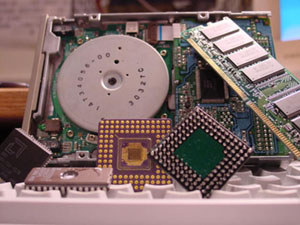
Original Link: https://www.anandtech.com/show/631
The Digital Future - A Guide to Digital Camera Reviewing
by Matthew Witheiler on October 6, 2000 3:32 AM EST- Posted in
- Guides
Slowly but surely digital devices have made their way into our homes as well as our lives. Some seemingly archaic devices were easy to replace with a better electronic equivalents, such as records and analog stopwatches. However, for every success story there are those devices have been slow to be adopted. Be it due to lack of technology or hesitation on the consumer's part, some think that digital equipment may never replace their analog counterparts. Take the 35mm camera for example. Ever since the release of the first batch of digital cameras, it was thought that the silver halide method of recording images would remain the choice medium for amateurs and professionals alike. Surely, a technology brought to the main stream a few short years ago could not rival an art that has been in use and constantly improved in over 160 years.
Well, as we see time and time again in the constantly changing field of electronics, digital photography has evolved in leaps in bounds since its introduction. The past 4 years have seen the digital camera grow from being a toy for most to nearly a 35mm replacement. Once again, it seems that the electronic way of doing things is destined to replace the conventional way of doing things for all but a select few.
We are not quite at this point in time yet, where conventional cameras seem archaic. While digital cameras offer features and usability never before seen in any type of camera, nearly every digital camera lacks some features and qualities that are found in well made conventional cameras. Be it in lens quality, image quality, or battery life, most digital cameras have at least one downside compared to conventional cameras. Throw these downsides in along with lack of advanced features, the inability to reproduce some colors accurately, and an utter lack of printing options, and one finds that the digital camera is still a step or two away from high quality 35mm cameras.
The vast quantity of digital cameras out there show that there is not only fierce competition but also a strong market for these expensive gadgets. With everyone from Agfa to Umax producing many different models of digital cameras, it is often hard to choose which digital camera is best for your needs. Each camera promises to appeal to different crowds, with each attempting to solve at least one if not all the problems associated with digital photography.
By introducing a new digital camera section into our ever growing list of review topics, we are expanding into an area that few have gone before. Putting to use our extensive knowledge of both computers as well as digital photography, AnandTech's digital camera reviews set out to take a very objective look at a very subject art: digital photography
This article is meant to serve as an introduction to future digital camera reviews. Reviewing key camera terms as well as testing methodology, this review guide will help the understanding of how AnandTech reviews digital cameras.
The Differences
With such a vast number of digital cameras currently available, it is no wonder that each one seems to offer features others do not. The differences between cameras can be subtle or drastic, depending on the camera type and the specified price range. For the most part a digital camera can be found in nearly every price range, from below one hundred dollars to upwards of thousands of dollars. Many of the differences between these cameras are related to their target audience.
While determining which audience you fall into may be easy, picking a camera in that price range is a different story. Like many other fields of electronics, there is usually no one obvious winner in the digital camera battle. Each camera seems to have advantages that others do not have, ranging from storage options to specified image quality. Yes, choosing the best digital camera in a given price range can be very difficult indeed.
Luckily, there are objective ways of rating digital cameras and showing how one camera may or may not stand out from others in the same price range. Mainly, the differences in digital cameras can be broken down into six topics: the design, the battery, the interface, the storage method, the lens, the features, and the image quality.
We will follow the above layout in upcoming digital camera reviews in order to examine how each camera performs in each category. Some of the review topics are inherently subjective, such as the camera design. In these categories, we will reflect upon our experiences with each camera, attempting to represent the average user.
Other categories, however, may seem inherently subjective. Take image quality for example. Some items, such as pixel count are easily measured objectively: simply compare numbers. Other aspects of image quality, on the other hand, are simply dismissed as subjective. Color truth is one such example. It seems like a very subjective subject, yet there is no question that some cameras capture realistic colors better than others. As you will see in later sections, this seemingly subjective topic can be looked upon very objectively given the right equipment.
Now we will discuss what kind of information will be expressed in upcoming reviews as well as define some photographic terms. Let's begin going down the category list, beginning with design.
The Design
 More
than just the outward appearance of any digital camera, a camera's design can
have a huge effect on its usability. What good is a built-in flash, for example,
if one's hand is constantly obscuring it's view? How can one put to use an excellent
LCD if one's hand is constantly covering it up?
More
than just the outward appearance of any digital camera, a camera's design can
have a huge effect on its usability. What good is a built-in flash, for example,
if one's hand is constantly obscuring it's view? How can one put to use an excellent
LCD if one's hand is constantly covering it up?
Many design flaws become apparent after some use of the camera. Button placement that may seem comfortable at first may soon become awkward with time. For this reason, each digital camera that falls into our hands is put through extensive field testing, involving both picture taking and picture review. In addition, each button is toyed with, giving us an overall feel of a camera and it's usability.
 Some
of the most common problems that are encountered when examining camera design
are awkward grips and poor button placement. Many times a camera sacrifices
adequate grip for size. Although making a camera pocket-sized is a great selling
feature, there is not much use for such a camera if the buttons are inaccessible
and the lens is easily covered. In addition, a camera with a good grip may place
buttons in hard to reach places. Ideally, a camera would mesh all three desirable
features into its design, incorporating small camera size with a meaty grip
and smart button placement. Unfortunately, this rarely happens.
Some
of the most common problems that are encountered when examining camera design
are awkward grips and poor button placement. Many times a camera sacrifices
adequate grip for size. Although making a camera pocket-sized is a great selling
feature, there is not much use for such a camera if the buttons are inaccessible
and the lens is easily covered. In addition, a camera with a good grip may place
buttons in hard to reach places. Ideally, a camera would mesh all three desirable
features into its design, incorporating small camera size with a meaty grip
and smart button placement. Unfortunately, this rarely happens.
 Don't
get us wrong, outward appearance is important too. As much as we may not want
to admit it, when we put down hundreds of dollars on a new piece of electronic
equipment that will constantly be in the public eye, looks do play a role. Of
two cameras with identical features, image quality, and price, one would naturally
have to place their decision on appearance. In addition, different people place
emphasis on different parts of a product. Indeed, some will value "coolness"
over functionality. Obviously, this is a subjective subject and thus we will
treat it accordingly, stating our personal opinion. Keep in mind, however, that
as with every other subjective subject, the review will state our opinion, which
may differ from others'.
Don't
get us wrong, outward appearance is important too. As much as we may not want
to admit it, when we put down hundreds of dollars on a new piece of electronic
equipment that will constantly be in the public eye, looks do play a role. Of
two cameras with identical features, image quality, and price, one would naturally
have to place their decision on appearance. In addition, different people place
emphasis on different parts of a product. Indeed, some will value "coolness"
over functionality. Obviously, this is a subjective subject and thus we will
treat it accordingly, stating our personal opinion. Keep in mind, however, that
as with every other subjective subject, the review will state our opinion, which
may differ from others'.
The Battery
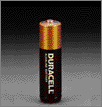 Closely
tied to design, each review will include a description of battery type and longevity,
as well as charging options. Battery type is much more diverse than one may
think, ranging in options from AA batteries to high capacity lithium ion cells.
Closely
tied to design, each review will include a description of battery type and longevity,
as well as charging options. Battery type is much more diverse than one may
think, ranging in options from AA batteries to high capacity lithium ion cells.
As one may suspect, charging is measured upon time required to charge the battery from it's fully depleted state to full charge. In addition, charging options are also weighed, such as an external battery charger or the like.
Finally, battery longevity is measured by actually using the camera in the field. To simulate actual camera use, pictures were taken during the testing, stressing both the effect of the memory writes as well as the occasional use of the flash. The LCD screen of the camera is left in the on state, as we find this to be the most convenient way to take pictures and really stresses the battery.
Storage
 Storage
options for digital cameras seem to come and go at breakneck pace. It seems
that new technologies for not only storing pictures but also moving them to
one's computer change almost monthly. However, with all this change, there does
seem to be one constant in the world of picture storage: Compact Flash memory.
This is not to say that Compact Flash is the best storage solution for the future,
it is just that the vast majority of digital cameras out there take advantage
of this technology, making it the mainstay of many digital cameras.
Storage
options for digital cameras seem to come and go at breakneck pace. It seems
that new technologies for not only storing pictures but also moving them to
one's computer change almost monthly. However, with all this change, there does
seem to be one constant in the world of picture storage: Compact Flash memory.
This is not to say that Compact Flash is the best storage solution for the future,
it is just that the vast majority of digital cameras out there take advantage
of this technology, making it the mainstay of many digital cameras.
Obviously there are other, and perhaps better, storage options out there, from the Sony Memory Stick to the IBM Microdrive. In each review we will investigate the camera's storage option, noting everything from write speed to maximum capacity. In addition, we will rate these storage options in terms of other ones out there.
 The
function of transferring images from the camera to one's computer varies greatly
from camera to camera. Some offer only basic TWAIN support accessible via an
onboard parallel port connection, while others go as far as including firewire
support. For the most part, cameras use the USB port to transfer data from the
camera to the computer, but other options such as a dedicated drive or floppy
support are out there as well.
The
function of transferring images from the camera to one's computer varies greatly
from camera to camera. Some offer only basic TWAIN support accessible via an
onboard parallel port connection, while others go as far as including firewire
support. For the most part, cameras use the USB port to transfer data from the
camera to the computer, but other options such as a dedicated drive or floppy
support are out there as well.
The Interface
User interface is crucial to proper camera function. Unlike conventional 35mm cameras, the vast majority of digital cameras provide a menu-based system to change everything from the camera's recording size to the noises it makes when taking a picture. While still subjective for the most part, the menu system of a camera usually strikes the user as either somewhat intuitive or not intuitive at all. The buttons used to access the menu system as well as how many layers deep commonly used features reside both influence the ease of the user interface.
How image review is gone about is also very crucial to the camera's interface. What good is being able to delete images from the camera if it takes many steps just to see the picture you took seconds ago?
In this section of digital camera reviews, look for screen shots as well as our personal input on how well the menu system of a particular camera works.
The Lens
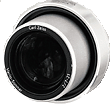 Perhaps
one of the most crucial aspects to the digital camera is the lens. Although
digital cameras share little in common with their 35mm counterparts, the lens
of a camera remains virtually unchanged. In fact, the lens of a camera can make
or break a digital camera's ability to produce realistic pictures. Let's go
over some of the key aspects of the digital camera lens.
Perhaps
one of the most crucial aspects to the digital camera is the lens. Although
digital cameras share little in common with their 35mm counterparts, the lens
of a camera remains virtually unchanged. In fact, the lens of a camera can make
or break a digital camera's ability to produce realistic pictures. Let's go
over some of the key aspects of the digital camera lens.
The lens performs the action of taking the external world and focusing it down to square the size of the camera's imaging sensor, which then records the image. There are quite a wide variety of lenses out there but all perform this fundamental action.
In addition to focusing down the image, the lens also determines how much light can get through to the imaging sensor. This setting is called aperture and is measured on cameras in f-stops. The f-stop of a lens determines how much light the camera can let through to the image sensor, with smaller f-stops resulting in a larger opening for light (aperture and f-stops are inversely related, meaning that a large f-stop equates to a small aperture). This opening is made from inside the lens via a set of overlapping "leafs" of sorts that act in a similar manner to the pupil of an eye.
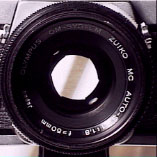 In
cameras, the aperture setting of the lens and the shutter speed of the camera
are closely related. This is because with a larger aperture (smaller f-stop)
the camera must use a faster shutter speed to expose the image properly. The
inverse is also true: a smaller aperture (larger f-stop setting) means that
the camera must use a slower shutter speed to let the proper amount of light
through. For a parallel, think of the human eye. Looking at a bright light while
one's pupil is dilated (related to a large aperture, small f-stop) causes one's
pupil to quickly contract when placed in a bright light situation to prevent
an image from looking too bright. The opposite happens with a contracted pupil
placed in dark light, which quickly dilates to make the image visible.
In
cameras, the aperture setting of the lens and the shutter speed of the camera
are closely related. This is because with a larger aperture (smaller f-stop)
the camera must use a faster shutter speed to expose the image properly. The
inverse is also true: a smaller aperture (larger f-stop setting) means that
the camera must use a slower shutter speed to let the proper amount of light
through. For a parallel, think of the human eye. Looking at a bright light while
one's pupil is dilated (related to a large aperture, small f-stop) causes one's
pupil to quickly contract when placed in a bright light situation to prevent
an image from looking too bright. The opposite happens with a contracted pupil
placed in dark light, which quickly dilates to make the image visible.
Typically, the more f-stop settings a lens has the better the lens. While a lens with many f-stop settings is harder to produce, it allows for more flexibility when picture taking. For example, in very low light situations, it is necessary to have a lens that has a very small f-stop setting so that the shutter speed can be adequate for the low level of light. Using a large f-stop in such a situation would require a very slow shutter speed, an undesirable situation when one is holding the camera in hand. Higher f-stop settings are good for bright situations where extremely fast shutter speeds are needed to produce the proper exposure.
For the most part, digital camera lenses fall far behind SLR (single lens reflex) 35mm cameras when it comes to f-stop settings. Generally, these lenses have many more f-stop settings allowing for picture taking in nearly every situation.
There are other aspects that aperture plays in picture taking. More advanced users may wish to adjust the f-stop setting of the camera to change the picture's depth of field, a term which describes how much of the picture's background is in focus. Generally, it can be thought that a larger f-stop (smaller aperture) produces both background and foreground in focus while a smaller f-stop (larger aperture) produces pictures where only the subject is in focus. We will elaborate on these terms in future reviews, but for now the general drift can be had.
In addition to f-stop settings, many digital camera lenses include a zoom feature. There are two types of zooms found on digital cameras: optical zoom and digital zoom. Optical zoom is just as it sounds, increasing or decreasing the image size by changing the position of the lens via an internal motor. In this type of case, the camera lens will typically extend itself form the camera body to alter the distance between the lens and the imaging sensor. Digital zoom is a feature not found on 35mm cameras. What digital zoom does is reproduce a zoom effect by essentially increasing the size of the image that the camera sees. Think of this as taking a smaller picture in an image editor and resizing it to a larger size.
Anyone who has performed such an action on an image knows that there are many undesired effects of digital zooming. Essentially, digital zoom increases the amount of graininess and fuzziness seen in the image. The digital zoom found in many digital cameras still have these problems, however many manufacturers includes an image enhancing algorithm to reduce the appearance of these artifacts. Unfortunately there is no question that the quality of a digital zoomed picture is far less clear than that of an optically zoomed picture.
In addition to the amount a lens can optically zoom, the speed at which it does so is also very important. When one wants to zoom in on that perfect shoot, speed is crucial. The slower the lens reacts to zooming in and out optically, the less ideal it is.
Finally, the type and quality of glass used in the lens elements is very important to final image quality. Poor quality glass can have a large effect on the clarity and color trueness of the resulting image.
One way to test how good the lens is at resolving images is to use an IEEE approved resolution chart. This chart contains a series of fine lines that come very close together. The quality of the lens is very dependent on how the camera distinguishes the lines between one another until it becomes just one solid line. Look for more on how to read this chart in future camera reviews.
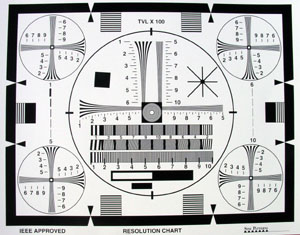
The Features
Along with increased image quality (as well as increased price) usually comes increased features. Features can be defined as additions that the camera has to make it stand out from the pack and act less like a 35mm camera and more like a photo-editing suite. Generally, the ability to switch from automatic mode to a manual mode where both shutter speed and f-stop can be controlled is greatly desired. Even if you go out not knowing anything about cameras, quickly you will learn how to adjust each setting to obtain the desired image. Without the ability to alter these settings, a camera becomes more of an entry level digital camera and less of a SLR replacement. Think of a camera without such custom features more along the lines of a nice 35mm automatic camera, while digital cameras with these settings are akin to more expensive and more powerful SLR cameras.
As one would suspect, the more features a camera has, the merrier. Ranging from the ability to adjust aperture and shutter speed to the ability to set white balance, camera features are diverse. Some even include settings to adjust the ISO rating of the camera (how sensitive the camera acts when exposed to light), something typically associated with SLR cameras. Features of digital cameras stretch as far as the ability to apply digital filters of sorts, changing the image completely such as making it black and white or inverting the colors, things never before imagined on conventional cameras.
While we understand that features are desirable, we also understand that many out there do not care as much about the features and are more interested in the point-and-shoot capabilities of the camera. Features, however, also play a large role in this, as the features determine items such as how many different preset picture modes there are and well as how the flash fires.
In this section of the review, we will get technical but more than that we will discuss the features of the camera when in automatic mode, meaning that both power users and novices can both see how the camera appeals to them.
Image Quality
 As
we discussed earlier, image quality is largely dependent on the lens. In addition
to the lens, the image sensing device that the camera uses also plays a large
role. A CCD (charged coupled device) is by far the most commonly used device.
A CCD is a small microchip that translates the light that falls on it into an
electrical signal. The "megapixel" count that is typically used to
rate CCDs is simply a count of the number of pixels that the CCD contains. The
more pixels the CCD contains, the smaller the amount of light the camera can
pick up and the the higher the image size will be.
As
we discussed earlier, image quality is largely dependent on the lens. In addition
to the lens, the image sensing device that the camera uses also plays a large
role. A CCD (charged coupled device) is by far the most commonly used device.
A CCD is a small microchip that translates the light that falls on it into an
electrical signal. The "megapixel" count that is typically used to
rate CCDs is simply a count of the number of pixels that the CCD contains. The
more pixels the CCD contains, the smaller the amount of light the camera can
pick up and the the higher the image size will be.
Both the camera lens and the CCD determine how true to life the pictures are. In order to measure this typically subjective subject, we have a few tricks up our sleeve.
First is the GretagMacbeth color checker, a small chart that contains patches of scientifically true color. Included for each color is the computer value for the color, making it very easy to reproduce the proper color on the computer. To see how a given digital camera represents color, all we need to do is compare the colors that the camera sees to the colors that are actually there. Below is a chart of the color checker produced in Adobe Photoshop. As you can see, quite a variety of colors are reproduced. To compare the actual colors to the colors that the camera picks up, we simply take a picture of the color checker chart (taken in daylight) and shrink the image down (to get the average value). Then, using the eye dropper tool in Photoshop, we can select the colors that the camera picks up and compare them to the actual colors. Pretty objective, if we do think so ourselves.

In addition, it is necessary to see how any given digital camera performs in a scene of sorts. In order to do this, we have developed our own test scene, shown below, that will be used to not only display different effects a digital camera, but also compare them with other cameras' pictures.
The Gallery
In this section we will post pictures taken with the camera over out time testing it. Look for some reoccurring images, but for the most part each review will have it's own unique set of images.
The Specs
On the specification page we will include a quick reference table that can be use to get a quick run down on the digital camera as a whole. This table will include information the lens (zoom, f-stop), as well as a quick information run down on all the camera's specs, such as image sizes, CCD count, CCD size, shutter speeds, ect. We will constantly be updating our database of cameras and after reading a review it may prove to be quite helpful to compare spec tables to each other. The table will also summarize the results of our testing, quickly comparing image quality, color trueness, and more.
In addition, technical terms will be defined via our key word pop-up windows, aiding in the understanding of some key photographic terms.
Conclusion
As you can see, reviewing digital cameras is quite a task. With many terms to explain, many features to test, and many pictures to take, why would we every go about tackling such a task?
Well the answer is simple. As your source for hardware analysis and news, it is crucial that we take an objective view of all new types of technology. Digital cameras just happen to be one front we are expanding to in order to keep you informed.
Taking the art of picture taking and turning it into an objective review is quite a task, but by following the format laid out above, it is not impossible. With the above format as our guide, expect to see many digital camera reviews to come you way over time. We hope you enjoy checking our our digital camera reviews as we enjoy making them.

